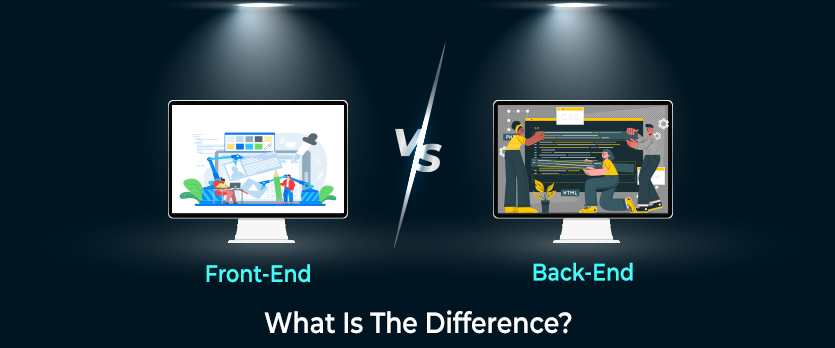The two most frequently used terms in the web industry are frontend and backend, but there is very little difference between the two. They are the two core components of software engineering that are crucial to the creation of websites. Backend is how everything functions, whereas frontend is what you see and interact with. In contrast to the backend, which you cannot see or interact with, the frontend may refer to the website’s graphical user interface. Although they are very different from one another, the two terms are extremely important for web development. They are very much like two sides of the same coin, despite the fact that they are each clearly distinct terms with their own functions. Each component’s ability to interact with one another as a whole is essential to a website’s functionality. The distinction between the two is discussed in this article.
Front-End Development
The frontend of a website is the area that you can view and use directly to access the system’s backend features. Everything that the user can see, feel, and experience is included. Although the fundamental duties of website development haven’t changed much over the years, the role of a web designer has. The website’s graphical user interface, which includes flashing buttons, vibrant graphics, navigation menus, etc., is all about the frontend. Because the action happens on the client side, in this case the user, frontend is often referred to as “client-side.” A client is typically used to refer to the computer programme that is viewing it, such a web browser.
Frontend development includes everything the user sees and interacts with on the website, which is mostly the web browser. The frontend development is responsible for a better user experience in terms of design and usability, and the role of the web designer is to, well, create websites. A web designer is not involved in the coding. In reality, he is in charge of handling every part of creating and redesigning websites with elements that are both aesthetically pleasing and have a user-friendly layout. A frontend developer’s job is to employ a variety of tools, such as HTML, CSS, and JavaScript, to create a world that the user can view and interact with.
Back-End Development
The portion of the website that you cannot view and interact with is the backend, which is also referred to as the “server-side.” Basically, backend web development is responsible for everything that takes place behind the scenes. Everything revolves on the website’s functionality; in a way, it serves as an indirect service provider for frontend development. It is the component of the system that is separated from the users. In contrast to the frontend, it runs on the server side but interacts with the frontend to make sure everything is functioning properly. Every application also has a sizeable amount of non-user interface code that manages all the intricate processes that operate in the background. Developers and programmers typically handle backend issues.
Everything that the web designer does that doesn’t involve providing a user interface, such writing APIs, building libraries, or including utilities, is handled by the backend developers. They make it easier for the presentation layer and business layer to communicate. In contrast to frontend web designers, they play a significant role in web development and have a highly collaborative function. Backend web development, in a nutshell, is the process of creating and maintaining a software application’s essential functional logic. To put it simply, backend developers create code to ensure that everything functions properly in the frontend. To make sure the website operates effectively, they typically spend more time than web designers figuring out logics and putting algorithms into place. It is a website’s brain.
Differences between Front-end and back-end Development
Backend vs. Frontend: Definition
The frontend of a website is the portion that visitors can see and interact with. It includes the design, menus for navigating, texts, images, and videos, as well as the graphical user interface (GUI) and command line. On the other hand, the backend is the portion of the website that visitors cannot access. Everything revolves around how it functions.
Frontend vs. backend: Roles
Both are essential to web development, and despite certain differences, they function as the two halves of the same coin. The visual elements of a website that a user may see and experience are all that the frontend is concerned with. In contrast, backend web development is responsible for everything that occurs in the background. It more closely resembles a frontend web experience enabler.
Frontend vs. Backend Developer
The most popular job title for frontend web development is “web designer,” and a web designer’s task is to create new websites while keeping their visual appeal in mind. The backend developers are responsible for ensuring the effective delivery of the data and systems required by the frontend software or applications. Backend developers are in charge of all background operations.
In contrast to the backend, which is essentially the “server-side” of the programme, frontend is also referred to as the “client-side” of the application. Languages like Java, Ruby, Python, PHP,.Net, and others are crucial for backend web development. The most popular frontend languages are JavaScript, CSS, and HTML.
Last Words
Although the backend and frontend are equally essential to how a website functions, there are some functional distinctions between them. They are like two halves of the same coin despite everything. The first is everything that a user can see and engage with, whereas the second is everything that a user cannot see. Backend refers to the server-side of the application, whereas frontend refers to the client-side. Both are essential to web development, yet their jobs, duties, and working conditions are very different. Backend is basically how everything operates, whereas frontend is what users see.
 +91 95109 87700
+91 95109 87700 +44 20 3290 3710
+44 20 3290 3710



